Moon Observing
Due to its relative long
f ratio (f/13.33), the small Zeiss is an ideal scope to observe the Moon.
In this section you'll be able to see some fine pictures and sketches of
the Moon, taken using different techniques; from conventional film cameras
to CCD devices and digital still cameras.
| Moon
Pictures. Click on thumbnails to enlarge them |
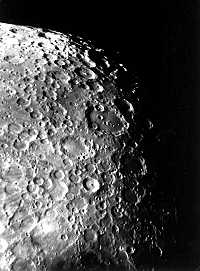
|
Author:
J. Paul Roux
Location: France
Used Technique:
Conventional 35mm photographic film
Image size:
400 x 542 pixels |
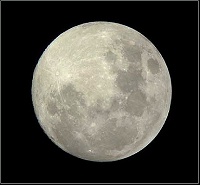
|
Author:
Gary Beal
Location: Auckland,
New Zealand
Used Technique:
Afocal method
Camera: Leica
digital camera
Image size:
431 x 398 pixels |
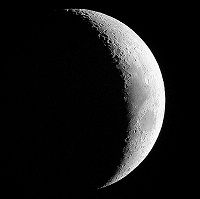
|
Author:
Luis Argüelles
Location: Quintueles,
near Gijón, Spain
Date: 24th,
July, 2001
Used Technique:
Afocal method
Used eyepiece(s):
Baader Planetarium Eudiascopic 35mm
Camera: Olmpus
C2000Z Digital
Image size:
508 x 506 pixels |
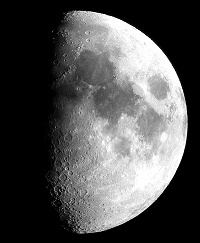
|
Author:
Luis Argüelles
Location: Quintueles,
near Gijón, Spain
Date: 28th,
July, 2001
Used Technique:
Afocal method
Used eyepiece(s):
Baader Planetarium Eudiascopic 35mm + Ultima 2x Barlow (48x)
Camera: Olmpus
C2000Z Digital
Image size:
502 x 609 pixels |
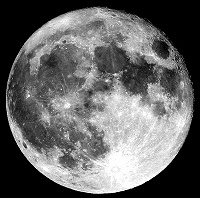
|
Author:
Luis Argüelles
Location: Quintueles,
near Gijón, Spain
Date: 4th,
August, 2001
Used Technique:
Afocal method
Used eyepiece(s):
Baader Planetarium Eudiascopic 35mm + Ultima 2x Barlow
Camera: Olmpus
C2000Z Digital
Image size:
649 x 641 pixels |
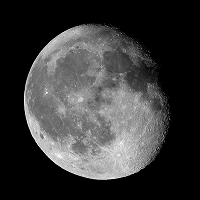
|
Author:
Luis Argüelles
Location: Sena
de Luna, Leon, Spain. (1,200 mts altitude)
Date: 3rd,
November, 2001
Used Technique:
Afocal method
Used eyepiece(s):
Baader Planetarium Eudiascopic 35mm + Ultima 2x Barlow
Camera: Olmpus
C2000Z Digital
Image size:
900 x 900 pixels |
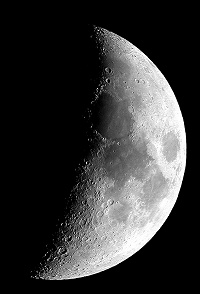
|
Author:
Luis Argüelles
Location: Deva,
near Gijón, Spain.
Date: 20th,
January, 2002
Used Technique:
Afocal method
Used eyepiece(s):
Baader Planetarium Eudiascopic 35mm + Ultima 2x Barlow
Camera: Olmpus
C2000Z Digital
Image size:
612 x 900 pixels |
|
|
|
The following Moon
Landscapes show resolution as low as 6-7 kms on the surface of our Satellite.
As you can see, significant craters and lunar features are named in the
images. You will note every image is "double". The one at left shows the
captions for the mentioned features, while the one at right, -coloured
in sepia in order to give a romantice tone- is caption-free. Enjoy from
this mini-atlas brought to you by one of the more incredible refractors
on Earth!
| Moon
Landscapes. Click on thumbnails to enlarge them |
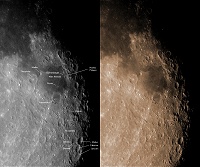
|
Author:
Luis Argüelles
Location: Sena
de Luna, Leon, Spain. (1,200 mts altitude)
Date: 3rd,
November, 2001
Used Technique:
Afocal method
Used eyepiece(s):
Baader Planetarium Eudiascopic 35mm + Ultima 2x Barlow
Other: Optical
camera's zoom used
Camera: Olmpus
C2000Z Digital
Image size:
1078 x 900 pixels
Craters and Features
named: Bohnenberger, Brenner, Fabricius, Fracastorius,
Jansen, Madler, Mare
Nectaris, Metius, Piccolomini, Pirineos Mountains, Rosse,
Stiborius, Theofilus
and Weinek |
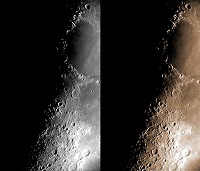
|
Author:
Luis Argüelles
Location: Deva,
near Gijón, Spain.
Date: 20th,
January, 2002
Used Technique:
Afocal method
Used eyepiece(s):
Baader Planetarium Eudiascopic 35mm + Ultima 2x Barlow
Other: Optical
camera's zoom used
Camera: Olmpus
C2000Z Digital
Image size:
904 x 774 pixels
Craters and Features
named: Abenezra, Abulfeda, Agrippa, Almanon, Andel,
Arago, Bessel, Boscovich,
Catharina, Cyrillus, Delambre, Dorsa Smirnov, Geber,
Godin, Julius Caesar,
Lade, Lindsay, Manilius, Mare Serenitatis, Menelaus,
Montes Haemus, Plinius,
Rima Ariadaeus, Ritter, Ross, Sabine, Theophilus and
Very (5.1 kms diameter) |
| |
|
|
|